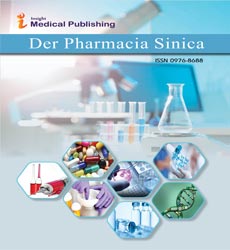ISSN : 0976 - 8688
Der Pharmacia Sinica
Antioxidant and Anti-Inflammatory Activities of Polyphenol-enriched Plant Extracts: A Pharmacognostic Study
Mareia Gonalez*
Department of Pharmacy, University of Barcelona, Barcelona, Spain
*Corresponding author:
Mareia Gonalez,
Department of Pharmacy, University of Barcelona, Barcelona, Spain,
E-mail: marie.gonalez@ubs.edu
Received date: January 02, 2025, Manuscript No. ipdps-25-20776; Editor assigned date: January 04, 2025, PreQC No. ipdps-25-20776 (PQ); Reviewed date: January 18, 2025, QC No. ipdps-25-20776; Revised date: January 24, 2025, Manuscript No. ipdps-25-20776 (R); Published date: January 31, 2025, DOI: 10.36648/2470-6973.16.01.03
Citation: Gonalez M (2025) Antioxidant and Anti-Inflammatory Activities of Polyphenol-enriched Plant Extracts: A Pharmacognostic Study. Der Pharmacia Sinica Vol.16.No.01: 03
Introduction
Plants have been an invaluable source of medicinal compounds for centuries, providing bioactive molecules that support human health. Among these, polyphenols-natural compounds widely distributed in fruits, vegetables, and medicinal herbs-have attracted significant attention for their antioxidant and anti-inflammatory properties. Oxidative stress and chronic inflammation are key contributors to a wide range of diseases, including cardiovascular disorders, diabetes, neurodegenerative conditions, and cancer. Pharmacognostic studies focusing on polyphenol-enriched plant extracts aim to identify, quantify, and evaluate the biological activities of these compounds, bridging traditional botanical knowledge with modern pharmacological insights. Such investigations not only validate ethnomedicinal practices but also facilitate the development of novel therapeutic agents derived from natural sources [1].
Description
Polyphenols encompass a diverse group of secondary metabolites, including flavonoids, phenolic acids, tannins, stilbenes, and lignans. These compounds are primarily responsible for the scavenging of free radicals and the modulation of cellular antioxidant defense systems. Phytochemical analysis using high-performance liquid chromatography (HPLC), gas chromatography-mass spectrometry (GC-MS), and spectrophotometric assays allows precise identification and quantification of polyphenolic content in plant extracts. Total phenolic content (TPC) and total flavonoid content (TFC) are commonly measured as indicators of antioxidant potential. Such analyses provide a foundation for correlating the presence of specific polyphenols with observed biological activities, enabling researchers to link molecular composition with therapeutic efficacy. Moreover, synergistic interactions among polyphenols within whole extracts often enhance overall efficacy compared to isolated compounds, highlighting the importance of studying extracts in their natural phytochemical context. Such insights inform the rational design of polyphenol-based nutraceuticals, functional foods, and phytopharmaceutical formulations [2].
The antioxidant activity of polyphenol-enriched extracts is predominantly evaluated through in vitro assays that measure free radical scavenging, metal chelation, and lipid peroxidation inhibition. Assays such as 2,2-diphenyl-1-picrylhydrazyl (DPPH) radical scavenging, ferric reducing antioxidant power (FRAP), and Oxygen Radical Absorbance Capacity (ORAC) are widely employed. These methods quantify the ability of plant extracts to neutralize Reactive Oxygen Species (ROS) or reactive nitrogen species, which are implicated in cellular damage and aging. Several studies have demonstrated that extracts rich in flavonoids, anthocyanins, and catechins exhibit strong antioxidant effects, often surpassing standard reference compounds such as ascorbic acid or Trolox. The antioxidant capacity not only protects cellular macromolecules from oxidative damage but also modulates signaling pathways involved in inflammation, apoptosis, and cellular homeostasis [3].
Anti-inflammatory activity, another key attribute of polyphenol-enriched plant extracts, is evaluated using both in vitro and in vivo models. In vitro assays typically measure the inhibition of pro-inflammatory enzymes such as cyclooxygenase (COX-1 and COX-2) and lipoxygenase (LOX), or the suppression of pro-inflammatory cytokines including tumor necrosis factor-alpha (TNF-α), interleukin-6 (IL-6), and interleukin-1 beta (IL-1β) in stimulated cell lines. In vivo models, such as carrageenan-induced paw edema or lipopolysaccharide-induced inflammation in rodents, provide physiological validation of anti-inflammatory effects. Polyphenols exert anti-inflammatory activity by modulating signaling pathways such as nuclear factor kappa B (NF-κB), mitogen-activated protein kinases, and Nrf2-mediated antioxidant response. The dual role of polyphenols in reducing oxidative stress and suppressing inflammatory mediators underscores their therapeutic potential in managing chronic inflammatory disorders. Pharmacognostic studies often combine phytochemical profiling with bioactivity-guided fractionation to identify the most active constituents within plant extracts. This integrative approach enables researchers to isolate and characterize specific polyphenols responsible for antioxidant and anti-inflammatory effects [4,5].
Conclusion
Polyphenol-enriched plant extracts represent a rich source of bioactive compounds with significant antioxidant and anti-inflammatory activities. Pharmacognostic studies combining chemical profiling with functional evaluation provide critical insights into the therapeutic potential of these natural products. By identifying active constituents, elucidating mechanisms of action, and validating biological effects through in vitro and in vivo assays, researchers can bridge traditional medicinal knowledge with modern drug discovery. The dual role of polyphenols in mitigating oxidative stress and modulating inflammation makes them promising candidates for preventing and managing chronic diseases. Continued exploration of polyphenol-rich plants, guided by integrative pharmacognostic approaches, is likely to yield novel therapeutic agents and nutraceuticals, advancing both scientific understanding and human health.
Acknowledgement
None.
Conflict of Interest
None.
References
- Mosmann T (1983). Rapid colorimetric assay for cellular growth and survival: Application to proliferation and cytotoxicity assays. J Immunol Methods65: 55-63.
Google Scholar Cross Ref Indexed at
- Livak KJ, Schmittgen TD (2001). Analysis of relative gene expression data using real-time quantitative PCR and the 2− ΔΔCT method. Methods25: 402-408.
Google Scholar Cross Ref Indexed at
- Herrera T, Del Hierro JN, Fornari T, Reglero G, Martin D. (2019). Inhibitory effect of quinoa and fenugreek extracts on pancreatic lipase and α-amylase under in vitro traditional conditions or intestinal simulated conditions. Food Chem270: 509-517.
Google Scholar Cross Ref Indexed at
- Del Hierro JN, Casado-Hidalgo G, Reglero G, Martin D. (2021). The hydrolysis of saponin-rich extracts from fenugreek and quinoa improves their pancreatic lipase inhibitory activity and hypocholesterolemic effect. Food Chem338: 128113.
Google Scholar Cross Ref Indexed at
- Gómez de Cedrón M, Laparra JM, Loria-Kohen V, Molina S, Moreno-Rubio J, et al. (2019). Tolerability and safety of a nutritional supplement with potential as adjuvant in colorectal cancer therapy: A randomized trial in healthy volunteers. Nutrients11: 2001.
Open Access Journals
- Aquaculture & Veterinary Science
- Chemistry & Chemical Sciences
- Clinical Sciences
- Engineering
- General Science
- Genetics & Molecular Biology
- Health Care & Nursing
- Immunology & Microbiology
- Materials Science
- Mathematics & Physics
- Medical Sciences
- Neurology & Psychiatry
- Oncology & Cancer Science
- Pharmaceutical Sciences
